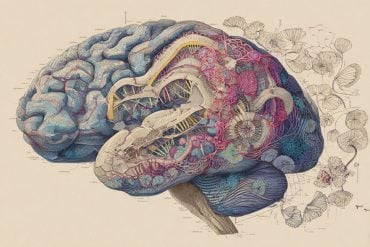Summary: Active social connection is the strongest protective factor for depression, a new study reports. Additionally, reducing sedentary activities such as watching TV or taking a nap can also help lower depression risk.
Source: Mass General
Researchers from Massachusetts General Hospital (MGH) have identified a set of modifiable factors from a field of over 100 that could represent valuable targets for preventing depression in adults. In a study published in The American Journal of Psychiatry, the team named social connection as the strongest protective factor for depression, and suggested that reducing sedentary activities such as TV watching and daytime napping could also help lower the risk of depression.
“Depression is the leading cause of disability worldwide, but until now researchers have focused on only a handful of risk and protective factors, often in just one or two domains,” says Karmel Choi, Ph.D., investigator in the Department of Psychiatry and the Harvard T.H. Chan School of Public Health, and lead author of the paper. “Our study provides the most comprehensive picture to date of modifiable factors that could impact depression risk.”
To that end, researchers took a two-stage approach. The first stage drew on a database of over 100,000 participants in the UK Biobank—a world-renowned cohort study of adults—to systematically scan a wide range of modifiable factors that might be associated with the risk of developing depression, including social interaction, media use, sleep patterns, diet, physical activity, and environmental exposures. This method, known as an exposure-wide association scan (ExWAS), is analogous to genome-wide association studies (GWAS) that have been widely used to identify genetic risk factors for disease. The second stage took the strongest modifiable candidates from ExWAS and applied a technique called Mendelian randomization (MR) to investigate which factors may have a causal relationship to depression risk. MR is a statistical method that treats genetic variation between people as a kind of natural experiment to determine whether an association is likely to reflect causation rather than just correlation.
This two-stage approach allowed the MGH researchers to narrow the field to a smaller set of promising and potentially causal targets for depression. “Far and away the most prominent of these factors was frequency of confiding in others, but also visits with family and friends, all of which highlighted the important protective effect of social connection and social cohesion,” points out Jordan Smoller, MD, ScD associate chief for research in the MGH Department of Psychiatry, and senior author of the study. “These factors are more relevant now than ever at a time of social distancing and separation from friends and family.” The protective effects of social connection were present even for individuals who were at higher risk for depression as a result of genetic vulnerability or early life trauma.

On the other hand, factors associated with depression risk included time spent watching TV, though the authors note that additional research is needed to determine if that risk was due to media exposure per se or whether time in front of the TV was a proxy for being sedentary. Perhaps more surprising, the tendency for daytime napping and regular use of multivitamins appeared to be associated with depression risk, though more research is needed to determine how these might contribute.
The MGH study demonstrates an important new approach for evaluating a wide range of modifiable factors, and using this evidence to prioritize targets for preventive interventions for depression. “Depression takes an enormous toll on individuals, families, and society, yet we still know very little about how to prevent it,” says Smoller. “We’ve shown that it’s now possible to address these questions of broad public health significance through a large-scale, data-based approach that wasn’t available even a few years ago. We hope this work will motivate further efforts to develop actionable strategies for preventing depression.” The study’s two-stage approach could also be used to inform the prevention of other health conditions.
About this depression research article
Source:
Mass General
Contacts:
Press Office – Mass General
Image Source:
The image is in the public domain.
Original Research: Closed access
“An Exposure-Wide and Mendelian Randomization Approach to Identifying Modifiable Factors for the Prevention of Depression” by Karmel W. Choi et all. American Journal of Psychiatry.
Abstract
An Exposure-Wide and Mendelian Randomization Approach to Identifying Modifiable Factors for the Prevention of Depression
Objective:
Efforts to prevent depression, the leading cause of disability worldwide, have focused on a limited number of candidate factors. Using phenotypic and genomic data from over 100,000 UK Biobank participants, the authors sought to systematically screen and validate a wide range of potential modifiable factors for depression.
Methods:
Baseline data were extracted for 106 modifiable factors, including lifestyle (e.g., exercise, sleep, media, diet), social (e.g., support, engagement), and environmental (e.g., green space, pollution) variables. Incident depression was defined as minimal depressive symptoms at baseline and clinically significant depression at follow-up. At-risk individuals for incident depression were identified by polygenic risk scores or by reported traumatic life events. An exposure-wide association scan was conducted to identify factors associated with incident depression in the full sample and among at-risk individuals. Two-sample Mendelian randomization was then used to validate potentially causal relationships between identified factors and depression.
Results:
Numerous factors across social, sleep, media, dietary, and exercise-related domains were prospectively associated with depression, even among at-risk individuals. However, only a subset of factors was supported by Mendelian randomization evidence, including confiding in others (odds ratio=0.76, 95% CI=0.67, 0.86), television watching time (odds ratio=1.09, 95% CI=1.05, 1.13), and daytime napping (odds ratio=1.34, 95% CI=1.17, 1.53).
Conclusions:
Using a two-stage approach, this study validates several actionable targets for preventing depression. It also demonstrates that not all factors associated with depression in observational research may translate into robust targets for prevention. A large-scale exposure-wide approach combined with genetically informed methods for causal inference may help prioritize strategies for multimodal prevention in psychiatry.






